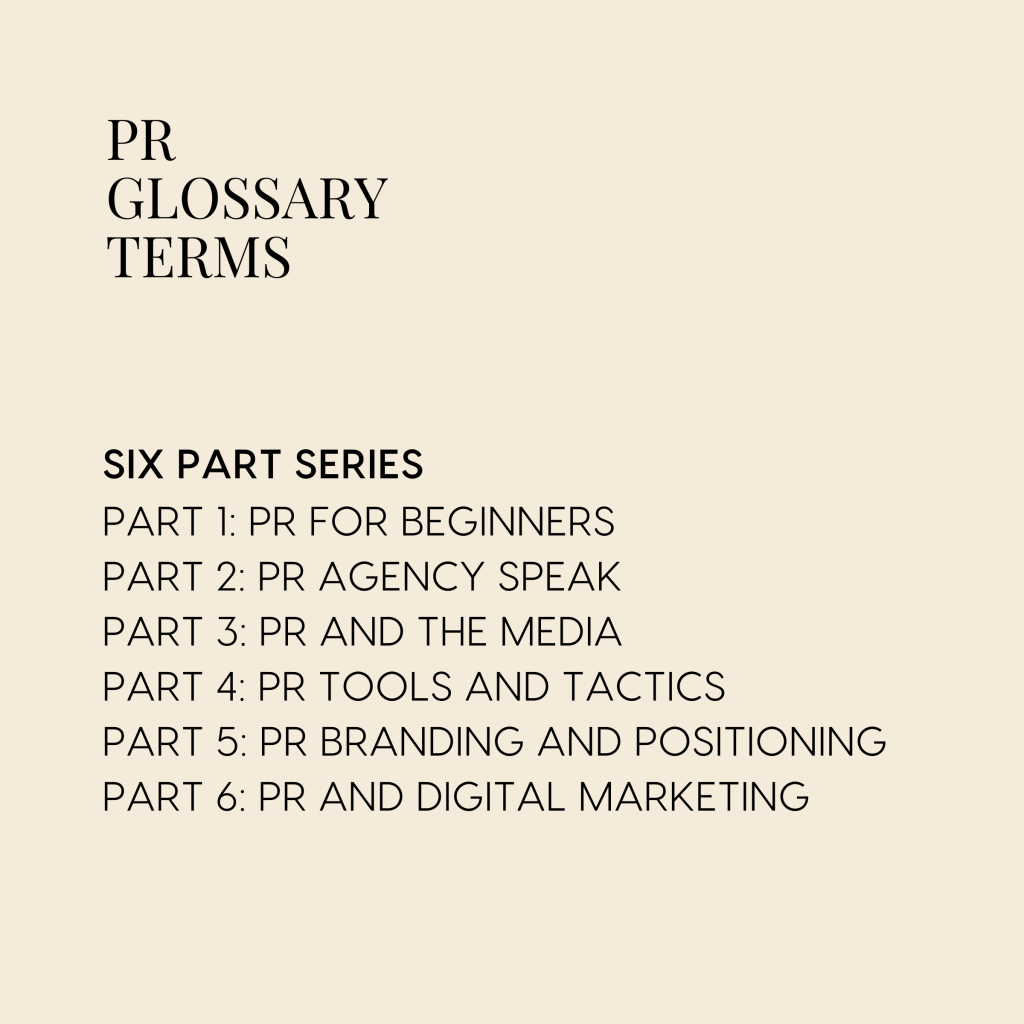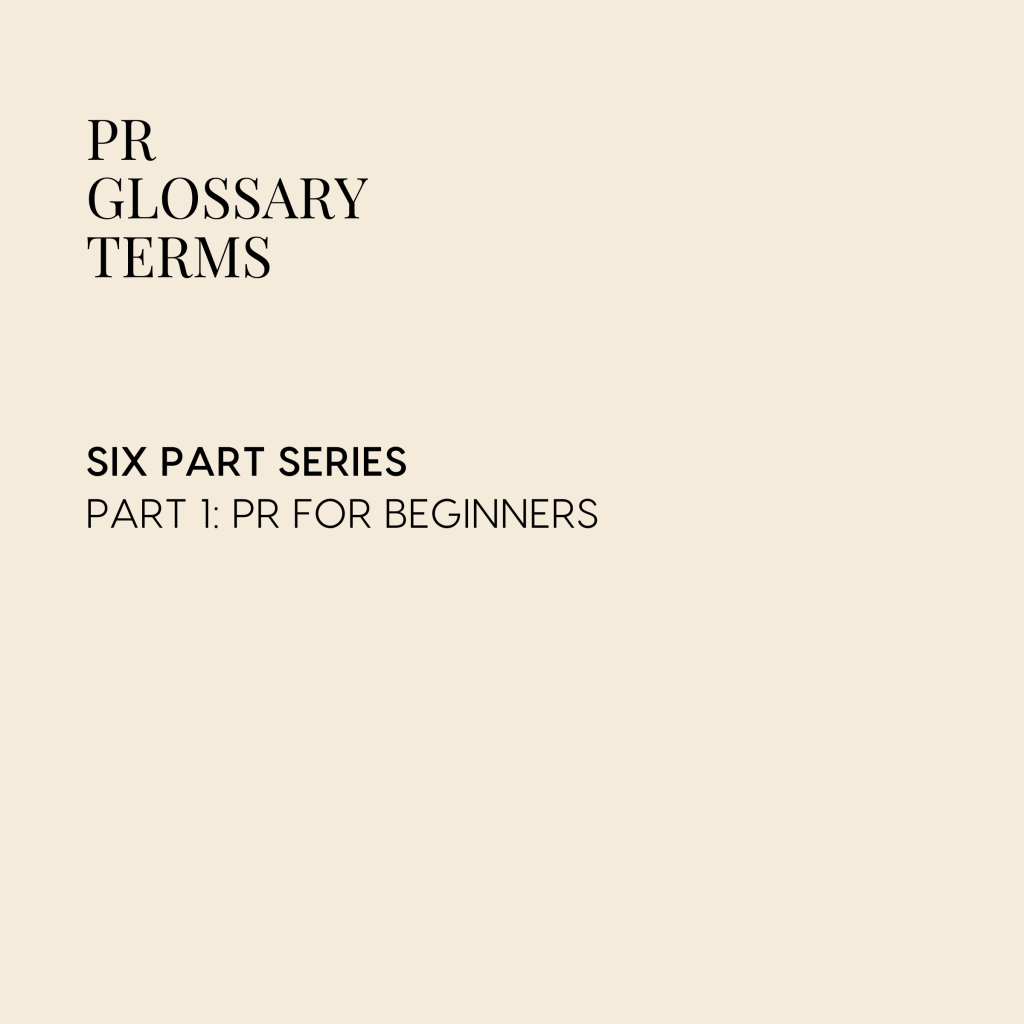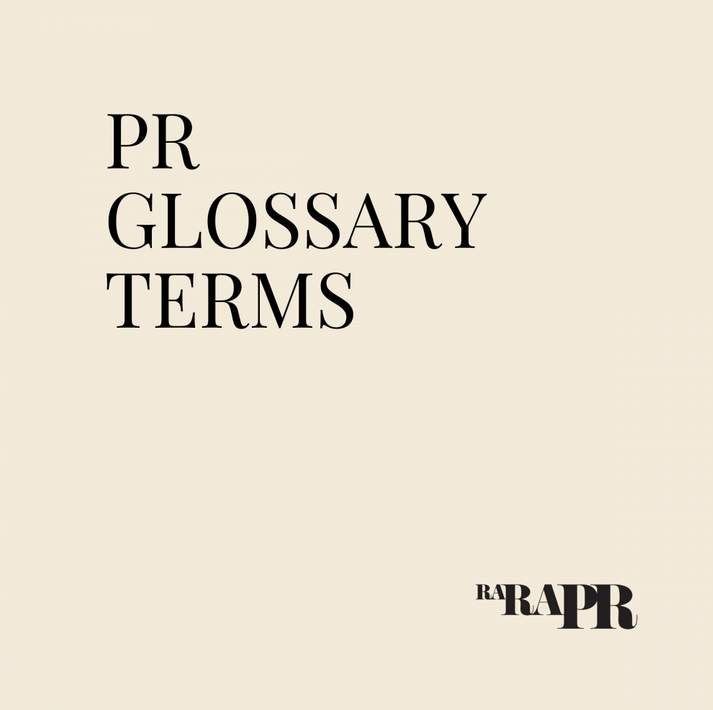

PART ONE | PR GLOSSARY TERMS | PR FOR BEGINNERS
> This blog is part of a six part series on all things PR Glossary Terms. Get around it if
- You run a business and you need a PR campaign, self-managed or not.
- You’re considering a career in PR.
- You’ve graduated with a PR degree and want to talk the talk or at least understand it. (In my experience most PR graduates have never come across these everyday PR terms. Believe it).
- You have a friend, child or sibling working in PR and you think PR is similar to Personal Assisting or some such, not sure, maybe.
- You’re a client to a PR agency or considering hiring a PR agency. (You know you need their help but you’re not sure what they’re saying, or why or what the hell they’ll be doing when you book them).
- You’re a supplier providing a service or collaborating with a PR agency.
PR FOR BEGINNERS SPEAK, LET’S GO…
PR: Spreading information to people its relevant to in order to connect and build communities on behalf of a person, place, thing, or service for commercial gains. Helping to sell things through storytelling, scouting for story and content ideas to unearth news. (*In the raraPR world we choose to work with businesses doing good and who are making the world better.). Link here for our more in-depth explanation of PR.
Publicity: Media Coverage in the media. Not to be confused with the holistic, dynamic and versatile function of PR in its entirety. Publicity is attention given to something by the media. Publicity should be news. Although sometimes that’s questionable.
Agency PR: When your PR is managed by a company that look after multiple clients at one time and work externally to your business. Agencies can provide up-to-the minute trends and industry insights as well as provide access to networks you wouldn’t otherwise be able to reach.
In-House PR: When the PR function is managed internally to the business.
Editorial: Content you see in the media that is not an ad. Editorial is media coverage usually generated by a PR person. Most other editorial is natural disasters and organic news (accidents and issues). Securing editorial is a dance of communication between a PR person and a journalist.
Advertorial: Media coverage that is actually an ad. A paid content space with pre-agreed creative and message outcomes but made to look like editorial. Advertising managers not PR place Advertorials people. Unless your PR consultant has an ad budget and can swing skills both ways.
Media Platform: A publication that produces content for the public be it digital/online, social media, TV, radio or print.
Media Placement: Secured coverage. Editorial that has appeared or is scheduled to appear.
Coverage Secured: When your story idea or editorial opportunity gets picked up. “Hold the phone people, it’s official, my coverage has been secured”.
Long-Lead: This refers to the time in advance media work to in developing and finalising content for their publication. Most glossy and lifestyle magazines as well as newspaper supplements are considered long-lead and work to three to four month lead-time. Or in other words, they collate and edit content about four months before the magazine reaches consumers.
Short-lead: Shorter than long-lead media and content platforms/outlets/publications that work to shorter media production times than long-lead. Anything from next day media coverage (i.e. newspapers, news radio, evening news, and news online) up to about two months lead-time (also includes weekly and fortnightly magazines) qualify as short-lead.
Consumers: The public. Aka, the group of people likely to buy, munch, drink, devour, or use your product, place, thing or service. Your target audience.
Newspaper Supplements: The lift-outs and mini magazines in print newspapers.
Media: A general and inclusive term for publications as a group that are producing content for the public.
Press: News media outlets producing news-based content. Actual news, issues and current affairs. Newspapers (print and online) are the press. It’s a term that derived from newspapers being press and stack printed. Magazines are not in the press category of media. Wrongly many people will refer to having written a press release and then send it to magazine media. Nope…a media release groups all media. A press release just refers to news media.
Print Media: Magazines, lifestyle and long lead media. Print media outlets are not press outlets.
Issues Management: PR strategies centred around resolving an issue for an organisation that is facing or may face issues affecting its consumers. Crisis and Issues management is often the activity of thinking about problems that might or could present problems for that business.
Pending: The result hasn’t happened yet but it is in progress.
Newswire: A Media Release and Media Alert syndication service that can transmit and send your news opportunity to targeted media or media en masse via satellite/the world wide web.
VNR: Stands for Video News Release. When news is syndicated to the media via video or film clip (hardly ever).
Crib Notes: Many moons ago (circa late 1700s) crib notes popped which referred to what we know as a ‘cheat sheet’. Crib notes are useful media angle planning tool where angles are assigned to media with notations on what your pitching to who, how and with any exclusive elements defined. Crib Notes are a PR’s editorial road map. It could also just be called an ‘Editorial Strategy’ or ‘Pitching Strategy’ or ‘Media Plan’, but it’s kinda fun keeping these old Latin terms alive.
Soundbite: A short extract from an interview or speech chosen to feature in a media release or news interview.
Byline: A byline tells the reader who wrote the article. A byline is a line or brief summary about the writer of an article in a newspaper, magazine or media outlet.
i.e. Jade Roberts, founder and director of raraPR is passionate about empowering small creative businesses to manage their own PR by providing them with access to world-class PR strategies. raraPR specialises in working with products and service-based businesses doing good for the world.
Endmark: This PR term refers to the word ‘ends’ at the end of a media release. It is customary to finish a media release with – ends – as a notation to inform the media that the news finishes from that point on. Anything after the word ‘ends’ is not part of the news. For example: PR contact details, a corporate biography, pricing and product info, or resourcing references.
Key Messages: THE most important messages to reach your target audience throughout their interactions with your business and throughout their customer journey.
Editorial: Content published in article style in a newspaper or magazine (online or print) written as news or expressing the editor’s opinion on a topical issue. It is not considered commercial content and is not paid for. It is placed content based on the editor’s decision to do so and journalistic integrity.
Circulation: The number of copies of a publication that said publication has distributed.
Readership: Not limited to the circulation number but rather the number of people exposed to the publication i.e. a magazine left in a medical clinic would count as one metric for circulation however the readership would be many more. Readership is usually predicted and refers to ‘pass-along readership’ aka not intentional consumers.
Content: This is not referring to being happy. It’s other meaning (said differently, spelt the same) is a communications word relating to purpose-created communicated information directed at an audience expressed through words, pictures or various art forms.
Cut-through: Communication that secures the attention of those it is intended for. PR experts will help you achieve cut-through with your messaging to your target audience.
Frequency: The number of times you secured coverage or cut-through.
Media Reach: Reach refers to the range of the media outlet’s distribution in relation to the target audience. It can relate to readership in a print media sense or audience scope for commercials on TV or radio.
Media Circulation This is the number of copies a publication has distributed within a pre-determined and defined period of time. Circulation relates to the number of intentional readers.
Broadcast Media: TV and radio media outlets (excludes print, online or social).
Coverage: Published content in the media by way of editorial that you’ve strategically and purposefully coordinated.
Media Kit: Relates to more than one item to be sent to media that communicates news and potential editorial opportunities. Usually includes a media release, company biography, founder biography, fact sheet, quality images, relevant website links and resources.
Media List: A strategically developed list of media contacts that forms the road map and basis of your media outreach and pitching strategy.
Outreach: Reaching out to or pitching to media. In simple terms, connecting with, speaking to, or hustling your face off to connect the thing you’re PRing with the media.
Media Pitch: When you pick up the phone (believe it), send an email or meet face to face with a journalist and hatch/present/propose a story idea for them to consider. The art of pitching is exactly that, an art.
Follow-up: Media receive a deluge of content and editorial opportunities to consider; follow-up is about making sure media have received and considered your editorial opportunity. It’s definitely not cool in PR to expect that just because you sent something that it was received; hence the need for committed follow-up. It’s equally not cool to be all pest-like. Skilled media follow-up considers various story ideas in case the initial one is declined as well as when the journalist is likely to be on deadline and not able to chat.
> READ ON FOR PART TWO, THREE, FOUR, FIVE AND SIX OF THIS SERIES.


